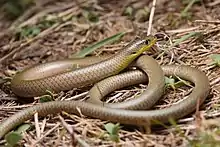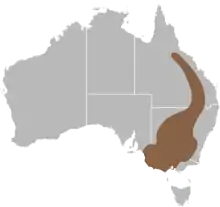Patternless delma
The patternless delma (Delma inornata) is a species of legless gecko from the Pygopodidae family.[2][3][4] This species is commonly found throughout New South Wales, Queensland and southeastern South Australia, mostly inhabiting areas consisting of dry to temperate southern grasslands and grassy woodlands.[5]
| Patternless delma | |
|---|---|
 | |
| Patterness delma (Delma inornata). Observed by Third Silence Nature Photography | |
| Scientific classification | |
| Domain: | Eukaryota |
| Kingdom: | Animalia |
| Phylum: | Chordata |
| Class: | Reptilia |
| Order: | Squamata |
| Family: | Pygopodidae |
| Genus: | Delma |
| Species: | D. inornata |
| Binomial name | |
| Delma inornata Kluge, 1974 | |
 | |
| Distribution of Delma inornata | |
Taxonomy
Delma inornata is also commonly referred to as the olive legless lizard,[6][7][8][9] olive snake-lizard,[10][11] olive delma lizard,[12] patternless legless lizard,[13] and common delma.[14] The species is a member of the Pygopodidae gecko family, which consists of approximately thirty legless, snake-like species endemic to Australia, with only two species found outside of mainland Australia.[15] These Pygododid lizards are closely related to the Diplodactylidae family of geckos. Distinguishing features include the absence of forelimbs, and replacement of hindlimbs for scaly-flaps, accompanied by snake-like, lidless eyes.[15]
The Delma genus, described by John Edward Gray in 1831, currently contains 22 described species.[11] This group of terrestrial legless lizards is characterised by well-developed hindlimb flaps, external ear openings and a broad, rounded tongue.[15] Head scales are relatively symmetrical and enlarged, with body scales consisting of 20 or fewer rows.[15]
Description
Morphology
Delma inornata is one of the largest species of the Delma genus, with an average snout-to-vent length of 13.3 centimetres (5.2 in),[11] and a tail which is typically 2-4 times the length of the body, and up to 2/3 of its total length.[10][15]
The dorsal colouration of this species is grey, grey-brown or olive brown, with specimens often sporting a yellow throat.[10][15] Scales are characterised by a dark outlining border, with ventral scales being a lighter whitish colouration.[11][15] Juveniles have been observed with darker scales on top of the head.[16]
The absence of a uniform pattern or unique features drove the naming of this species, as these features are often a characterizing trait of Delma species. Its smooth scales are in typically 16 rows but can range from 15-18, with ventral scales being wider than the adjacent body scales. This species is further identifiable by three enlarged pre-anal scales and 3-5 scales on the lower hindlimb flap.[15]
Differentiation
The species which most closely resembles Delma inornata, and which overlaps in distribution, is the occasionally stripe-less striped legless lizard, Delma impar. The best known difference between these taxa is the fusion or partial fusion of the nasal and first supra-labial scale in Delma impar, and the clear separation of these scales in Delma inornata. However, this is inconsistent, with some specimens of Delma impar having clearly separated nasal and first supra-labial scales. Despite this, experienced workers are able to identify specimens of either species.[7][17] Delma butleri has also been misidentified as Delma inornata.[18]
South Australia
The population of patternless delma in South Australia are likely isolated from the main population in Victoria and New South Wales. For example, although 90% of patternless delma have 2 supranasal scales,[19] a study of South Australian specimens revealed a supermajority (78%) of individuals had 1 supranasal scale.[20]
Distribution
This species has a relatively wide distribution, spanning across much of the interior of the east coast of Australia.[15] Delma inornata ranges from the region of Darling Downs in south-east Queensland, then extends down south, to the west of the Great Dividing Range in New South Wales to the south-east region of South Australia.[11][15] There have been records of isolated populations in Northern Queensland and Central Queensland.[10][15]
Habitat
This species is found to inhabit dry to temperate grasslands and grassy woodlands of the southeast Australian temperate savanna in the southern portion of its distribution, whereas it occupies temperate, wetter forests alongside the ranges and slopes of the Great Dividing Range to the north of its distribution.[10][15]
In the westernmost part of its range, Delma inornata is found in drier plains, woodlands and mallee communities, foraging for small invertebrates in spinifex, porcupine grass and other tussock grasses.[10][11] For example, in the Mount Lofty Ranges of South Australia, Delma inornata is associated with open grassy remnants without a shrub layer, with leaf litter protection on the ground. Delma inornata uses logs and surface debris for cover and protection from predators, and relies on dense and low grassy feeding areas.[10][15]
The patternless delma also occurs in farming and grazing lands, where vegetation is often cleared and therefore sparse. These populations have adapted to use farming equipment such as water troughs, along with rocks, metal and wooden debris for cover.[10]
Ecology
.jpg.webp)
Ecosystem
Delma inornata are most active at dusk and dawn, but also forages during the day in summer.[10] At least in the southernly portions of its range, Delma inornata becomes dormant in the winter months, either burying itself up to 30cm into the soil, or hiding under fallen timber or industrial litter. The species has also evolved to resemble young brown snakes, which can be highly venomous. This defensive mimicry has also induced human-caused fatalities due to this resemblance.[10][12]
Diet
The diet of the patternless delma mainly consists of arthropods, particularly insects, with a study finding that a Delma inornata specimen had a stomach content analysis showing it contained 76% insect matter.[21] They are found to mainly target surface active insects such as cockroaches, grasshoppers and adult butterflies & moths, along with spiders and caterpillars.[10][12][15]
Feeding behaviour
Head morphology and jaw structure are the features influencing the feeding mechanisms and behaviour of Delma inornata. A relatively small head tied with the tight jaw bone structure of this species results in a low level of cranial kinesis, meaning they are unable to attack and ingest larger prey items in comparison to species from Lialis.[22]
Reproduction
.jpg.webp)
All species of Delma are defined as oviparous. The majority of species will lay two eggs per clutch, with eggs being parchment-shelled, and elongated.[15] Breeding occurs in the early summer season, where ideal temperatures remain consistent- pregnant females have been found in January.[10][15]
Human interaction
The patternless delma makes a squeaking noise when disturbed or handled. In captivity, agonistic behaviour is common among adults. Captive juveniles will attack small skinks.[10]
Although present on farming & grazing lands, and willing to tolerate moderate levels of habitat modification by humans, human-related threats include further land clearing and fragmentation, predation by feral animals, use of pesticides, habitat disruption and direct mortality by trampling ungulates and humans mistaking Delma inornata for juvenile brown snakes.[10][11][12]
References
- Shea, G.; Cogger, H.; Greenless, M. (2017). "Delma inornata. The IUCN Red List of Threatened Species 2018: e.T102830712A102830721". IUCN Red List. doi:10.2305/IUCN.UK.2018-1.RLTS.T102830712A102830721.en. Retrieved 16 October 2022.
- Shea, G.; Cogger, H.; Greenless, M. (2017). "Delma inornata. The IUCN Red List of Threatened Species 2018: e.T102830712A102830721". IUCN Red List. doi:10.2305/IUCN.UK.2018-1.RLTS.T102830712A102830721.en. Retrieved 16 October 2022.
- "Delma inornata: Patternless Delma". Atlas of Living Australia. Retrieved 16 October 2022.
- "Australian Reptile Online Database - Patternless delma profile". Retrieved 31 March 2023.
- Wilson, Steve; Swan, Gerry (2008). A complete guide to Reptiles of Australia (Second ed.). New Holland Publishers (Australia) Pty Ltd. ISBN 9781877069468. OCLC 676930737.
- "Olive Legless Lizard". Wangaratta Chronicle. 2021-04-23. Retrieved 2023-03-29.
- Smith, Warwick J. S.; Robertson, Peter (June 1999). "National Recovery Plan for the Striped Legless Lizard (Delma impar) 1999-2003". NSW National Parks and Wildlife Service & Wildlife Profiles Pty Ltd – via Department of Climate Change, Energy, the Environment and Water - Australian Government.
- Robertson, Geoff (4 June 2017). "Australian Capital Territory and Yass Valley Reptiles". Landcare NSW.
- "Striped Legless Lizard Action Plan" (PDF). ACT Environment, Planning and Sustainable Development Directorate – via ACT Government.
- Biodiversity Conservation Unit (2009). "Olive Snake-lizard Factsheet" (PDF). Department for Environment and Heritage - Regional Recovery Plan for Threatened Species and Ecological Communities of Adelaide and the Mount Lofty Ranges, South Australia 2009 - 2014 – via Government of South Australia.
- Allen, Luke; Mann, Shen (2015). "A NEW POPULATION OF THE OLIVE SNAKE - LIZARD DELMA INORNATA KLUGE, 1974 (REPTILIA: PYGOPODIDAE) ON THE SOUTHERN FLEURIEU PENINSULA, SOUTH AUSTRALIA WITH RECOMMENDATIONS ON LOCAL CONSERVATION INITIATIVES". South Australian Naturalist, 2015. 89 (1): 20–26. Retrieved 30 March 2023 – via ResearchGate.
- "Legless and harmless, these Australian lizards are no snakes in the grass". ABC News. 2022-12-29. Retrieved 2023-03-29.
- "Delma inornata Kluge, 1974, Patternless Legless Lizard". Museums Victoria Collections. Retrieved 2023-03-29.
- "Patternless delma". Australian Geographic. 2017-06-12. Retrieved 2023-03-29.
- Cogger, Harold (2018). Reptiles & Amphibians of Australia (Seventh ed.). CSIRO Publishing. ISBN 9781486309696. OCLC 1061116404.
- Wilson, Stephen; Knowles, David (1988). Australia's reptiles : a photographic reference to the terrestrial reptiles of Australia / Stephen K. Wilson & David G. Knowles. Collin's Publishers. ISBN 0-7322-0011-3. OCLC 19796176.
- "Striped Legless Lizard vs Olive Legless Lizard". Striped Legless Lizards in North East Victoria. 2011-08-01. Retrieved 2023-03-29.
- Shea, G. M. (1991). Revisionary Notes on the Genus Delma (Squamata: Pygopodidae) in South Australia and the Northern Territory. Vol. 1 (25 ed.). Adelaide: Records of the South Australian Museum. pp. 71-90 (85).
{{cite book}}: CS1 maint: date and year (link) - Kluge, Arnold G. (1974). "A taxonomic revision of the lizard family Pygopodidae". University of Michigan Museum of Zoology.
- Shea, G. M. (1991). Revisionary Notes on the Genus Delma (Squamata: Pygopodidae) in South Australia and the Northern Territory. Vol. 1 (25 ed.). Adelaide: Records of the South Australian Museum. pp. 71-90 (85).
{{cite book}}: CS1 maint: date and year (link) - Patchell, Frederick C.; Shine, Richard (1986-02-10). "Food Habits and Reproductive Biology of the Australian Legless Lizards (Pygopodidae)". Copeia. 1986 (1): 30–39. doi:10.2307/1444884. JSTOR 1444884.
- Patchell, P.C; Shine, R. (1986). "Feeding Mechanisms in Pygopodid Lizards: How Can Lialis Swallow Such Large Prey". Journal of Herpetology. 20 (1): 59–64. doi:10.2307/1564125. JSTOR 1564125.
